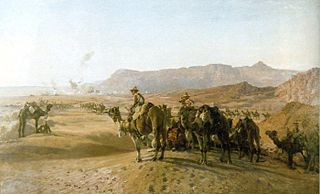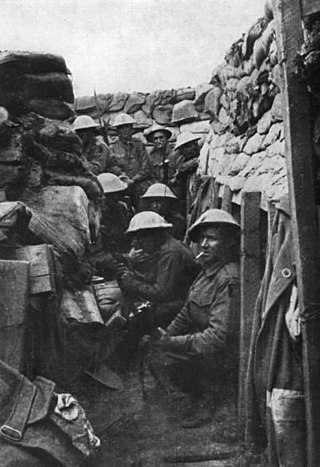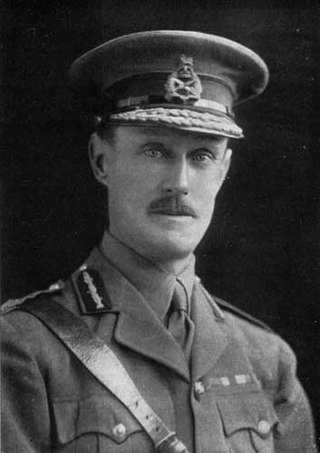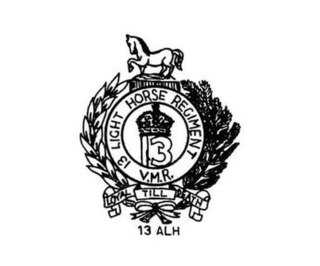
The Battle of Magdhaba took place on 23 December 1916 during the Defence of Egypt section of the Sinai and Palestine Campaign in the First World War. The attack by the Anzac Mounted Division took place against an entrenched Ottoman Army garrison to the south and east of Bir Lahfan in the Sinai desert, some 18–25 miles (29–40 km) inland from the Mediterranean coast. This Egyptian Expeditionary Force (EEF) victory against the Ottoman Empire garrison also secured the town of El Arish after the Ottoman garrison withdrew.

The First Australian Imperial Force was the main expeditionary force of the Australian Army during the First World War. It was formed as the Australian Imperial Force (AIF) following Britain's declaration of war on Germany on 15 August 1914, with an initial strength of one infantry division and one light horse brigade. The infantry division subsequently fought at Gallipoli between April and December 1915, with a newly raised second division, as well as three light horse brigades, reinforcing the committed units.

The New Zealand and Australian Division was a composite army division raised for service in the First World War under the command of Major General Alexander Godley. Consisting of several mounted and standard infantry brigades from both New Zealand and Australia, it served in the Gallipoli Campaign between April and December 1915.

The I ANZAC Corps was a combined Australian and New Zealand army corps that served during World War I.

The II ANZAC Corps was an Australian and New Zealand First World War army corps. Formed in early 1916 in Egypt in the wake of the failed Gallipoli campaign, it initially consisted of two Australian divisions, and was sent to the Western Front in mid-1916. It then took part in the fighting in France and Belgium throughout 1916 and 1917, during which time it consisted of New Zealand, Australian and British divisions. In November 1917, the corps was subsumed in to the Australian Corps, which concentrated all five Australian infantry divisions. After this, the corps was reformed as the British XXII Corps.

The New Zealand Division was an infantry division of the New Zealand Expeditionary Force raised for service in the First World War. It was formed in Egypt in early 1916 when the New Zealand and Australian Division was renamed after the detachment of its Australian personnel left the New Zealand Infantry Brigade, together with reinforcements from New Zealand, as the basis of the division. It was commanded by Major General Andrew Hamilton Russell for the duration of the war.

The Battle of Rafa, also known as the Action of Rafah, fought on 9 January 1917, was the third and final battle to complete the recapture of the Sinai Peninsula by British forces during the Sinai and Palestine campaign of the First World War. The Desert Column of the Egyptian Expeditionary Force (EEF) attacked an entrenched Ottoman Army garrison at El Magruntein to the south of Rafah, close to the frontier between the Sultanate of Egypt and the Ottoman Empire, to the north and east of Sheikh Zowaiid. The attack marked the beginning of fighting in the Ottoman territory of Palestine.

The Australian and New Zealand Army Corps (ANZAC) was originally a First World War army corps of the Mediterranean Expeditionary Force. It was formed in Egypt in December 1914, and operated during the Gallipoli campaign. General William Birdwood commanded the corps, which primarily consisted of troops from the First Australian Imperial Force and 1st New Zealand Expeditionary Force, although there were also British and Indian units attached at times throughout the campaign. The corps disbanded in 1916, following the Allied evacuation of the Gallipoli peninsula and the formation of I ANZAC Corps and II ANZAC Corps. The corps was re-established, briefly, in the Second World War during the Battle of Greece in 1941. The term 'ANZAC' has been used since for joint Australian–New Zealand units of different sizes.

General Sir Alexander John Godley, was a senior British Army officer. He is best known for his role as commander of the New Zealand Expeditionary Force and II Anzac Corps during the First World War.

In Australia, the outbreak of World War I was greeted with considerable enthusiasm. Even before Britain declared war on Germany on 4 August 1914, the nation pledged its support alongside other states of the British Empire and almost immediately began preparations to send forces overseas to engage in the conflict. The first campaign that Australians were involved in was in German New Guinea after a hastily raised force known as the Australian Naval and Military Expeditionary Force was dispatched in September 1914 from Australia and seized and held German possessions in the Pacific. At the same time another expeditionary force, initially consisting of 20,000 men and known as the Australian Imperial Force (AIF), was raised for service overseas.

The 13th Light Horse Regiment was a mounted infantry regiment of the Australian Army during the First World War. The regiment was raised in March 1915, and eventually assigned as the mounted regiment for the Australian Corps. During the war the regiment fought against the forces of the Ottoman Empire, at Gallipoli, and against the German Empire on the Western Front. For its role in the war the regiment was awarded twelve battle honours. In 1921, it was later re-raised as a part-time unit of the Citizens Forces, and was briefly amalgamated with the 19th Light Horse. During the Second World War, the regiment was converted into an armoured regiment, designated the "13th Armoured Regiment", although it was disbanded in late 1943 without seeing action.

Lieutenant Colonel Charles Hellier Davis Evans, DSO served as commanding officer of the New Zealand Cyclist Corps. A long time member of New Zealand's volunteer forces he enlisted in the New Zealand Expeditionary Force at the outbreak of World War I, and served with distinction on the Western Front. He was awarded the Distinguished Service Order, Mentioned in Despatches, and was one of only 14 members of the New Zealand Army to receive the French Legion of Honour decoration during the war.
Chaytor's Force named after its commander, Major General Edward Chaytor, was a composite division-sized force which served in the British Egyptian Expeditionary Force during the Sinai and Palestine Campaign of the First World War. The force of 11,000 men, consisted of a division headquarters, three mounted and one infantry brigades, four independent infantry battalions and four artillery batteries and was detached from the Desert Mounted Corps for deception operations.

The Second Battle of Amman was fought on 25 September 1918 during the Third Transjordan attack as part of the Battle of Nablus which together with the main Battle of Sharon form the major set piece offensive known as the Battle of Megiddo of the Sinai and Palestine Campaign in World War I. After cutting the road from Nablus to Es Salt on 22 September Chaytor's Force captured the bridge over the Jordan River at Jisr ed Damieh while units of the Seventh Army and remnants of the Eighth Army were still in retreating towards the bridge from the Judean Hills. Having cut this line of retreat, Chaytor's Force proceeded eastwards to attack and capture Es Salt, before riding on to attack and capture the Ottoman rearguard of the Fourth Army defending Amman. These British Empire victories of the Third Transjordan attack over Yildirim Army Group forces, followed two unsuccessful EEF attacks across the Jordan River in March and April 1918.

The Desert Column was a First World War British Empire army corps which operated in the Sinai and Palestine Campaign from 22 December 1916. The Column was commanded by Lieutenant General Philip W. Chetwode and formed part of Eastern Force. When Chetwode took command of Eastern Force after the Second Battle of Gaza, Harry Chauvel took command and oversaw the expansion of the column to three divisions.

The third attack on Anzac Cove was an engagement during the Gallipoli Campaign of the First World War. The attack was conducted by the forces of the Ottoman Turkish Empire, against the forces of the British Empire defending the cove.

The Australian Army was the largest service in the Australian military during World War I. The First Australian Imperial Force (AIF) was the Army's main expeditionary force and was formed from 15 August 1914 with an initial strength of 20,000 men, following Britain's declaration of war on Germany. Meanwhile, the separate, hastily raised 2,000-man Australian Naval and Military Expeditionary Force (AN&MEF), landed near Rabaul in German New Guinea on 11 September 1914 and obtained the surrender of the German garrison after ten days; it later provided occupation forces for the duration of the war. In addition, small military forces based on the pre-war Permanent Forces and part-time Citizen Forces were maintained in Australia to defend the country from attack.

The Australian Cycling Corps was formed in Egypt in 1916 as part of the Australian Imperial Force (AIF), and fought on the Western Front in France and Belgium during World War I. They were used mainly as despatch riders, while also conducting reconnaissance and patrolling. It was disbanded in 1919.
The II ANZAC Corps Mounted Regiment was a combined mounted unit made up of Australian and New Zealand troops during the First World War. The regiment served on the Western Front between 1916 and 1918. For the most part, the regiment undertook rear area duties, although it undertook more mobile operations in early 1917 during the German withdrawal to the Hindenburg Line. In November 1917, the regiment was redesignated as the XXII Corps Mounted Regiment when II ANZAC Corps was converted into XXII Corps. During early 1918, the regiment played a defensive role during the German spring offensive and then supported French operations during the Second Battle of the Marne. The regiment continued operations throughout the remainder of 1918, supporting the Allied Hundred Days Offensive until the end of the war.
The Wellington West Coast Regiment was a territorial infantry regiment of the New Zealand Military Forces. The regiment traced its origins to the Wanganui Rifle Volunteers, a volunteer corps formed in 1860. The volunteer corps provided men to the New Zealand contingents sent to South Africa during the Second Boer War and in 1911 became the 7th Regiment. During the First World War, the regiment provided a company to each of the battalions of the Wellington Infantry Regiment, which saw combat at Galipolli and on the Western Front. After the war the regiment was renamed the Wellington West Coast Regiment and remained in New Zealand for home defence during the Second World War. Men from the regiment, however, served with the 19th, 22nd, 25th and 36th Battalions of the Second New Zealand Expeditionary Force. In 1948, the Wellington West Coast Regiment was amalgamated with the Taranaki Regiment and became the Wellington West Coast and Taranaki Regiment.


















